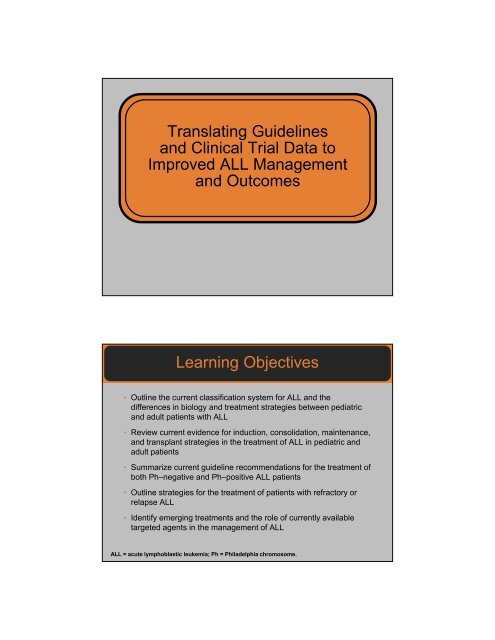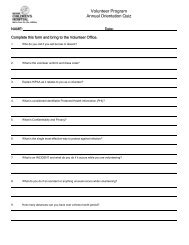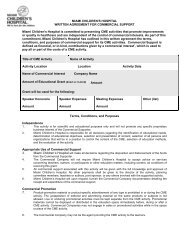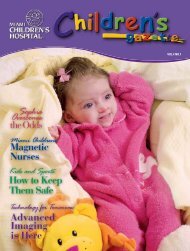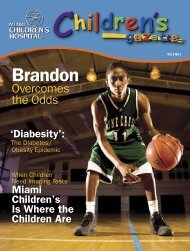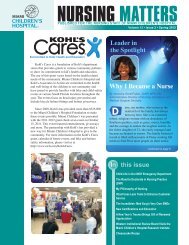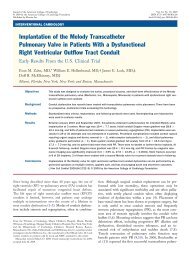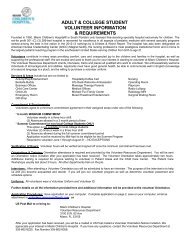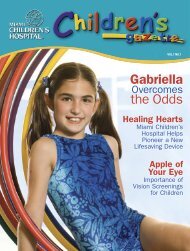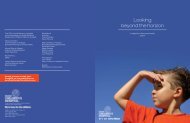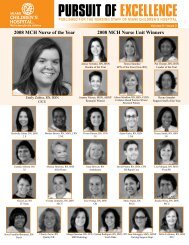Translating Guidelines and Clinical Trial Data to and ... - Amazon S3
Translating Guidelines and Clinical Trial Data to and ... - Amazon S3
Translating Guidelines and Clinical Trial Data to and ... - Amazon S3
You also want an ePaper? Increase the reach of your titles
YUMPU automatically turns print PDFs into web optimized ePapers that Google loves.
<strong>Translating</strong> <strong>Guidelines</strong><strong>and</strong> <strong>Clinical</strong> <strong>Trial</strong> <strong>Data</strong> <strong>to</strong>Improved ALL Management<strong>and</strong> OutcomesLearning Objectives• Outline the current classification system for ALL <strong>and</strong> thedifferences in biology <strong>and</strong> treatment strategies between pediatric<strong>and</strong> adult patients with ALL• Review current evidence for induction, consolidation, maintenance,<strong>and</strong> transplant strategies in the treatment of ALL in pediatric <strong>and</strong>adult patients• Summarize current guideline recommendations for the treatment ofboth Ph–negative <strong>and</strong> Ph–positive ALL patients• Outline strategies for the treatment of patients with refrac<strong>to</strong>ry orrelapse ALL• Identify emerging treatments <strong>and</strong> the role of currently availabletargeted agents in the management of ALLALL = acute lymphoblastic leukemia; Ph = Philadelphia chromosome.
Acute Lymphoblastic Leukemia• 6050 new ALL cases in the United States annually• ALL accounts for 20% of adults with acute leukemia <strong>and</strong> ~80% ofall childhood leukemia cases– 60% of ALL patients are younger than 20 years-of-age– ALL accounts for 25% of all childhood cancers– ALL is more common in males: 62%• Greatest incidence in the United States among Hispanics– Higher incidence in whites vs blacks– Peak incident rate: 2-5 years-of-age; >50 years-of-ageAmerican Cancer Society. http://www.cancer.org/Research/CancerFactsFigures/CancerFactsFigures/cancer-facts-figures-2012. Accessed January 4, 2013. Jemal A, et al. CA Cancer J Clin. 2004;54(1):8-29.Risk Stratification <strong>and</strong> Classification ofALL at the Time of Diagnosis• NCI risk fac<strong>to</strong>rs for pediatric ALL (BCP>TCP)– Age• St<strong>and</strong>ard risk: >1 year-of-age;
Distribution of the Common ChromosomalAbnormalities According <strong>to</strong> Age10090Pro oportion of Cases (%)8070605040302010t(4;11)/11q23t(12;21)HeHt(9;22)t(1;19)14q32Other00 1-4 5-9 10-14 15-19 20-24 25-29 30-34 35-39 40-44 45-49 50-54 55-59Age (years)HeH = high hyperdiploidy.Harrison CJ. Clin Lab Med. 2011;31(4):631-647.Genetic AbnormalitiesAre Not R<strong>and</strong>omB-Cell Development Stages, Immunophenotype,Major Transcription Fac<strong>to</strong>rs, <strong>and</strong> Signaling MoleculesPU.1E2AIKAROS (IKZF1)IL-7R/CRLF2PAX5EBFlgH Rearrangementpre-BCRlgK or L RearrangementBCRHSCLMPPCLPPrepro-BPro-BLargepre-BSmallpre-BImmBIL-7 ResponsivePre-BCRCD34+CD10+CD19-CD34+CD10-CD19+CD34+CD10+CD19+CD34-CD10+CD19+CD34-CD10+CD19+CD20+lgM+EBF = early B-cell fac<strong>to</strong>r; Ig = immunoglobulin; HSC = hema<strong>to</strong>poietic stem cell; LMPP = lymphoidprimedmultipotential progeni<strong>to</strong>r; CD = cluster of differentiation; IL = interleukin.Zhou Y, et al. Human Pathol. 2012;43(9):1347-1362.
Age at Diagnosis Correlates withOutcomeProbability1.00.908 0.80.70.60.50.40.31-9 Years (n=598)>15 Years (n=78)0.210-15 Years (n=153)0.150 chromosomes39 9.56±3.59 (5-20) 1.59±2.49 (0-11) 11.13±5.0 (5-27)B-ALL TCF3-PBX1 17 1.59±0.62 (1-3) 2.12±1.17 (1-4) 3.7±1.53 (2-7)B-ALL ETV6-RUNX1 47 0.89±1.51 (0-8) 6.0±4.63 (1-21) 6.68±4.8 (0-21)B-ALL rMLL 11 0.09±0.3 (0-1) 0.91±1.81 (0-6) 1±1.79 (0-6)B-ALL BCR-ABL1 9 4±5.3 (0-12) 4.2±4.15 (0-12) 6.8±4.52 (0-13)B-ALLHyperdiploidy with47-50 chromosomes23 1.70±1.55 (0-7) 3.5±3.12 (0-12) 5.1±4.31 (0-15)B-ALL Hypodiploid 10 1.1±1.91 (0-6) 6.0±4.42 (3-18) 7.1±6.12 (3-24)B-ALL Other 36 1.06±3.21 (0-19) 4.64±5.14 (0-20) 5.58±6.57 (0-23)B-ALL Total 192 2.97±4.28 (0-20) 3.83±4.2 (0-21) 6.63±5.56 (0-27)T-ALL 50 0.9±1.98 (0-9) 4.9±6.21 (0-30) 5.8±7.12 (0-39)All Cases 242 2.54±4.0 (0-20) 4.06±4.69 (0-38) 6.46±5.90 (0-39)*Range is shown in parentheses.B-ALL = acute B-lymphoblastic leukemia; T-ALL = acute T-lymphoblastic leukemia.Mullighan CG, et al. Nature. 2007;446(7137):758-764.
MRD on Day 29 of Induction PredictsBoth Early <strong>and</strong> Late FailurePOG9904+9905+9906Early RelapseLate Relapseree Survival ProbabilityRelapse-F1.00.90.80.70.60.50.40.30.20.10Negative (n=1588)Positive (n=383)P0.01%) (n=68)0.10P
CCR for Patients in the SR <strong>and</strong> HR GroupsAccording <strong>to</strong> Molecular Response Statusrobability of CCRPWeek 16 in Adult ALL PatientsOverall1.01.00.90.90.80.80.70.70.6Molecular0.6CR: 69% (n=384)0.5Molecular0.50.4Failure: 26% (n=120)0.40.30.30.20.10P
Case 1:13-cv-10020-MLW Document 1 Filed 01/04/13 Page 8 of 1128. Plaintiffs have been <strong>and</strong> are continuing <strong>to</strong> be damaged by Defendants’infringement <strong>and</strong>/or inducement of infringement of the ‘830 patent.COUNT II(Infringement of United States Patent No. 5,770,193)29. Plaintiffs repeat <strong>and</strong> reallege the allegations contained in paragraphs 1 through 28above as if fully set forth herein.30. SRM infringes <strong>and</strong> has infringed, either literally or under the doctrine ofequivalents, one or more claims of the ‘193 patent under 35 U.S.C. 271(a), by the manufacture ofDermagraft.31. SRM induces <strong>and</strong> has actively induced infringement under 35 U.S.C. 271(b) <strong>and</strong>contributed <strong>to</strong> the infringement, under 35 U.S.C. 271(c), of one or more claims of the ‘193patent, either literally or under the doctrine of equivalents.32. SRM sells <strong>and</strong> offers <strong>to</strong> sell Dermagraft in the United States for treatment ofdiabetic foot ulcers, <strong>to</strong>gether with instructing, directing, <strong>and</strong>/or advising others how <strong>to</strong> carry outmethods of treatment that infringe one or more claims of the ‘193 patent.33. SRM sells Dermagraft with a package insert that includes instructions for treatingdiabetic foot ulcers in a manner that infringes one or more claims of the ‘193 patent. Whenphysicians or others use Dermagraft according <strong>to</strong> the instructions set forth in the package insertprovided by SRM, such acts constitute direct infringement of one or more claims of the ‘193patent, either literally or under the doctrine of equivalents.34. SRM knew or should have known that its actions would induce others <strong>to</strong> infringethe ‘193 patent <strong>and</strong> knew that Dermagraft was especially made or adapted for use in aninfringing manner. Dermagraft is a material component of the inventions claimed in the ‘193patent <strong>and</strong> is not a staple article of commerce capable of substantial noninfringing use.8
Induction TherapyTreatment OptionsPediatricNew YorkCOG/SRCOG/HR+T-cellAdultLinkerUKALL XIIAgentsVincristine, prednisone, daunomycin, asparaginase, CPMVincristine, DXM, prednisone, asparaginaseVincristine, DXM or prednisone, prednisone, asparaginase,daunomycinVincristine, DXM or prednisone, asparaginase, daunomycinVincristine, DXM or prednisone, asparaginase, daunomycinHyperCVADVincristine, i DXM, doxorubicin, i hyperfractionated t CPMCPM = cyclophosphamide; COG = Children’s Oncology Group; UKALL = Medical Research CouncilAcute Lymphoblastic Leukemia; HyperCVAD = hyperfractionated cyclophosphamide, vincristine,doxorubicin, <strong>and</strong> dexamethasone.National Cancer Institute. http://www.cancer.gov/cancer<strong>to</strong>pics/pdq/treatment/childALL/HealthProfessional/page4. Accessed January 14, 2013. NCCN <strong>Clinical</strong> Practice <strong>Guidelines</strong> in Oncology.http://www.nccn.org/professionals/physician_gls/pdf/all.pdf. Accessed January 4, 2013.Presymp<strong>to</strong>matic CNS Therapy(CNS Prophylaxis)• Effective systemic chemotherapy– HD MTX, DXM, asparaginase, thioguanine• Early intensification <strong>and</strong> optimization of intrathecaltherapy– Triple IT therapy vs IT MTX• Cranial irradiation– A central role in the 1960’s but employed less because ofserious long-term sequalaeHD = high dose; MTX = methotrexate; IT = intrathecal.Pui CH, et al. Semin Oncol. 2009;36(4 suppl 2):S2-S16.
CCG-Modified St<strong>and</strong>ard BFMInduction(5 weeks)VPLDConsolidation(8 weeks)VPLD CPM2 weekCPM 2-weekAraC delay AraC delay6-MP6-MP16 weeks of intensive therapy including6 weeks of delay for count recoveryInterim Maintenance(8 weeks)Oral 6-MP/Oral MTXDelayed Intensification(8 weeks)Vincristine/DXM/Doxorubicin/L-asparaginaseCPMAraC6-MP2-weekdelayNachman JB, et al. N Engl J Med. 1998;338(23):1663-1671.Augmented BFMInduction(5 weeks)Consolidation(8 weeks)VPLDCPMAraC6-MPCPMAraC6-MPVincristine-L-asparaginaseVincristine-L-asparaginaseNo delays—40 weeks of intensive therapyInterim Maintenance #1(8 weeks)Vincristine/Capizzi MTX +L-asparaginaseInterim Maintenance #2(8 weeks)Vincristine/Capizzi MTX +L-asparaginaseDelayed Intensification(8 weeks)Vincristine/DXM/ CPMDoxorubicin/ AraCL-asparaginase 6-MPDelayed Intensification(8 weeks)Vincristine/DXM/Doxorubicin/L-asparaginaseCPMAraC6-MPVincristine-L-asparaginaseVincristine-L-asparaginaseNachman JB, et al. N Engl J Med. 1998;338(23):1663-1671.
Longer <strong>and</strong> Stronger PIICCG-18821009080EFS (%)7060500sAugmented therapySt<strong>and</strong>ard therapy (n=156)P
EFS During 5 Years ofFollow-Up in ALL PatientsEFS According <strong>to</strong> the Type of Post-Induction Chemotherapy1.00.90.80.70.60.50.40Log Rank P
DXM vs Prednisone;HD vs Escalating IV MTXAALL0232On StudyPrednisone x 28 DaysDXM x 14 DaysRapidEarly ResponderSlowEarly ResponderRapidEarly ResponderSlowEarly ResponderAugmentedConsolidationAugmentedConsolidationAugmentedConsolidationAugmentedConsolidationVincristine/Capizzi MTX6-MP/HD MTXVincristine/Capizzi MTX6-MP/HD MTXVincristine/Capizzi MTX6-MP/HD MTXVincristine/Capizzi MTX6-MP/HD MTXDelayedIntensificationDelayedIntensificationDelayedIntensificationDelayedIntensificationDelayedIntensificationDelayedIntensificationDelayedIntensificationDelayedIntensificationDelayedIntensificationDelayedIntensificationVincristine/Capizzi MTXVincristine/Capizzi MTXDelayedIntensificationDelayedIntensificationVincristine/Capizzi MTXVincristine/Capizzi MTXDelayedIntensificationDelayedIntensificationDelayedIntensificationDelayedIntensificationMaintenanceMaintenanceMaintenanceMaintenanceAALL0232 = high-risk precursor B-ALL pro<strong>to</strong>col.Larsen EC, et al. Presented at: 2011 American Society of <strong>Clinical</strong> Oncology Annual Meeting; June 3-7,2011; Chicago, Illinois. Abstract 3.AALL0232—Excluding Ph+, Hypodiploid,MLL; Including RER <strong>and</strong> SERProbabilityOverall EFS Comparison for Capizzi vs HD MTX1.00.90.80.70.60AALL0232 EFS Outcome Capizzi MTX vs HD MTX.50(R<strong>and</strong>omized, non-DS-ALL <strong>and</strong> non-VHR patients only).40Log Rank P=.006.30 5-Year EFS: Capizzi MTX 75.4% (AEs 3.6%) vs HD MTX 82.0% (AEs 3.4%).20HD MTX (n=1209).10Capizzi MTX (n=1217)00 1 2 3 4 5 6 7Years from Study EntryNumber at Risk:Capizzi MTX 1217 883 679 460 288 105 10HD MTX 1209 895 689 483 305 103 12MLL = Mixed-Lineage Leukemia gene; RER = rapid early response; SER = slow early response; DS-ALL = Down’s syndrome <strong>and</strong> ALL; VHR = very high-risk.Larsen EC, et al. Presented at: 2011 American Society of <strong>Clinical</strong> Oncology Annual Meeting; June 3-7,2011; Chicago, Illinois. Abstract 3.
Maintenance• Daily mercap<strong>to</strong>purine + weekly MTX since the 1960s– Full dose is more effective than half dose– CPM <strong>and</strong> cytarabine add <strong>to</strong>xicity but no benefit– Childhood ALL is unique in requiring prolonged therapy• 2 years>18 months; 3 years>2 years• L92-13 study with 1 year of intensive therapy– 60% EFS for HR <strong>and</strong> 60% EFS for SR– Vincristine/steroid pulses– Parenteral vs oral MTXPinkel D. Cancer. 1979;43:1128-1137. Tsuchida M, et al. Leukemia. 2010:24(2):383-396. Eden T, et al. BrJ Haema<strong>to</strong>l. 2010;149(5):722-733. Wehinger H, et al. Klin Padiatr. 1982;194(4):214-218. Koizumi S, et al.Cancer. 1988;61(7):1292-1300. Br<strong>and</strong>elise S, et al. J Clin Oncol. 2010;28(11):1911-1918.COG Treatment Allocation
Pediatric BCP Risk StratificationAALL0932/AALL1131Day 8 PB MRD 1%Day 29 BM MRD
Risk Stratification: Pediatric, T-CellAALL0434PresentingFeaturesAge 1-9 yearsWBC 10 yearsWBC >50,000Testes diseaseCNS 3M1 on Day 8 or 15 M1 on Day 29 M2/3 on Day 29 orDay 29 MRD 1%LR IR HRIRHR• No validity of conventional age/WBC• End consolidation MRD (day 85!)• Adverse ETPM1, 2, 3 = bone marrow morphology stages; ETP = early T-phenotype.Schultz KR. J Clin Oncol. 2009;27(31):5175-81. Krampera M, et al. Br J Haema<strong>to</strong>l. 2003;120(1):74-9.Willemse MJ, et al. Blood. 2002;99(12):4386-93.Early T-Cell Phenotype:Molecularly HeterogeneousCD1a(-), CD8(-), CD5(weak) with Stem-Cell or Myeloid MarkersZhang J, et al. Nature. 2012;481(7380):157-163.
St. JudeEarly T-Cell Phenotype:Molecularly HeterogeneousCD1a(-), CD8(-), CD5(weak) with Stem-Cell or Myeloid MarkerslityProbabiNumber at Risk:TypicalETPAIEOPilityProbabiNumber at Risk:TypicalETP1.00.80.60.40.2EFS00 2 4 6 8 10 12 14 16Years122 108 75 59 46 29 14 717 12 4 3 1 1 1 11.0871374534122%Remission Failure/Hema<strong>to</strong>logic Relapse1.069% 0.872%P
“Targeted Therapy”Ph+ ALL in Children; Pre-ImatinibYears ofStudy Groups Study N Percentage CR EFS ReferenceDana-Farber 1981-89 15 3.5 80 0 Fletcher et al (1991)POG 1981-8989 58 23 2.3 78 7 Crist et al (1990)St. Jude 1984-94 23 3.6 87 33 Ribeiro et al (1987)BFM/AEIOP 1986-95 61 1.3 75 38 Schrappe et al (1998)NOPHO 1986-97 17 1.3 NA 41 Forestier et al (2000)CCG 1988-95 30 2.3 97 20 Uckun et al (1998)UKALL 1990-97 25 2 NA 27 Hann et al (2001)Dana-Farber 1991-95 6 1.6 100 50 Silverman et al (2001)St. Jude 1994-98 6 2.9 89 29 Pui et al (2004)AEIOP 1995-99 30 2 86 46 Arico et al (2002)UKALL 1997-2002 42 2.3 86 52 Roy et al (2005)AEIOP = Associazione Italiana Ema<strong>to</strong>logia Oncologia Pediatrica; NOPHO = Nordic Society forPediatric Hema<strong>to</strong>logy <strong>and</strong> Oncology.Jones LK, et al. Br J Haema<strong>to</strong>l. 2005;130(4):489-500.Imatinib + Chemotherapy Improves Outcomefor Childhood Ph+ ALL (AALL0031)EFS ProbabilityEFS by Cohort 1-2 vs 3-51.0 1.00.90.80.70.60.50.40.3P=.01780.2Cohort 1/2 (n=17)Cohort 3/4 (n=22)0.1Cohort 5 (n=44)00 1 2 3 4YearsEFS Probability0.90.80.70.60.50.40.30.20.10P=.0062AALL0031 Cohort 5 vsHis<strong>to</strong>rical ControlAALL0031 (n=44)His<strong>to</strong>rical Controls (n=56)0 2 4 6 8YearsAALL0031 = Evaluation of imatinib mesylate in<strong>to</strong> an intensive chemotherapy regimen for children withPh+ ALL.Schultz KR, et al. J Clin Oncol. 2009;27(31):5175-5181.
Targeted Therapy• Every agent has molecular targets– MTX <strong>and</strong> DHFR• Targeted therapy requires a patient population for whom themolecular target is critical– ATRA → acute promyelocytic leukemia– TKIs → chronic myelogenous leukemia– Abnormal gene product (BCR-ABL; RARα)– Over-expression?expression?• Target should clonal—not sub-clonal• “Early” vs “late” disease– Chronic myelogenous leukemia vs Ph+ ALLDHFR = dihydrofolate reductase; ATRA = all-trans-retinoic acid; TKIs = tyrosine-kinase inhibi<strong>to</strong>rs;RARα = retinoic acid recep<strong>to</strong>r-alpha.CRLF2 <strong>and</strong> JAK2 in B-Cell Progeni<strong>to</strong>r ALL:A Novel Association in OncogenesisRuxolitinib?Overexpression of CRLF2PotentialtherapeuticinterventionAnti-CRLF2antibodyapproachesJAK2-WTCRLF2overexpression(5%-15% B-ALL,60% DS-ALL)Normal CRLF2function(part of TSLPrecep<strong>to</strong>r with IL7Rα)MonomerHomodimerHeterodimer(with unknownpartner)MutanthomodimerMutantheterodimer(with unknownpartner)JAK2mutation(30%-70%)JAK2-WTCRLF2mutation(10%-20%)Mutation ofother kinases?(10%-60%)UnknownKinasesJAK2-MTorUnknownKinasesJAK2-WTorUnknownKinasesJAK2-MTJAK2-WTJAK2-WTKinase-MTKinaseinhibi<strong>to</strong>rsAberrant growthcontrol signalingin B-ALLAberrant signaling contributing<strong>to</strong> B-ALL developmentCRLF2Unknown= CRLF2 = F232C = IL7Rα = HeterodimericMutantRecep<strong>to</strong>rWT = wild-type; MT = mutated; TSLP = thymic stromal lymphopoietin; IL7Rα = interleukin 7 recep<strong>to</strong>ralpha.Roll JD, et al. Cancer Res. 2010;70(19):7347-7352.
Adolescents <strong>and</strong> Young AdultsInduction RateEFS<strong>Trial</strong>s Age (years) Adult Pediatric Adult PediatricFRALLE-93/LALA-9415-20 83% 94% 41% 61%DCOG/HOVON 15-18 91% 98% 34% 69%NOPHO92/Swedish Group15-18/15-20 90% 99% 39% 74%ALL97/UKALLXII15-17 94% 98% 49% 65%CCG/CALGB 16-20 90% 90% 34% 63%NOPHO/FinnishGroup10-16/16-25 97% 96% 60% 67%FRALLE = French Acute Lymphoblastic Leukemia Group; LALA-94 = Leucemies AiguesLymphoblastiques de l’Adulte-94; DCOG = Dutch Childhood Oncology Group; HOVON = DutchHaema<strong>to</strong>-Oncology Association Studies; CALGB = Cancer <strong>and</strong> Leukemia Group B.McNeer JL, et al. Curr Opin Oncol. 2012;24(5);487-494.Treatment Allocation—AdultThe Best Management of Any Patient Is a <strong>Clinical</strong> <strong>Trial</strong>Ph- ALL• Age 15-39 or >65 years <strong>and</strong> nosubstantial comorbidities– Chemotherapy as in pediatrics– Allogeneic BMT if MRD+ orHR• Aged >65 years orcomorbidities– Multiagent chemotherapy• Dose reductions– CorticosteroidsPh+ ALL• Aged 15-64 years, nocomorbidities– Chemotherapy + TKI– Allogeneic BMT (donor)• Aged >65 years orcomorbidities– Corticosteroids + TKIBMT = bone marrow transplantation.NCCN <strong>Clinical</strong> Practice <strong>Guidelines</strong> in Oncology. http://www.nccn.org/professionals/physician_gls/pdf/all.pdf. Accessed January 4, 2013.
ALL Relapse <strong>and</strong> Its Affect onPatient SurvivalRelapsed ALL is the 7th MostCommon Childhood MalignancyCases/10 6 children/y year353025201510530.927.69.78.4 8.3Relapse ALL6.65.64.5 3.90AML = acute myeloid leukemia.Adapted from: Gaynon PS, et al. Cancer. 1998;82(7):1387-1395.
Algorithm for Treatment of BMRelapse ALL in ChildrenBM RelapseCombined withExtramedullary LocalizationIsolatedTreat asIsolatedBM Relapse+ +SR (BCP-ALL Relapsing>6 Months fromTreatmentDiscontinuation)HR (BCP-ALL Relapsing
BM RelapseVery EarlyCR1 36 months Combined 49% (60) 60% (124)No differences from 1989-1995 vs 1996-2002Gaynon PS, et al. Cancer. 1998;82(7):1387-1395. Nguyen K, et al. Leukemia. 2008;22(12):2142-2150.AALL01P2—First BM RelapseOutcomes in MRD Positive vs NegativeEFS Probability1.00.90.80.70.60.50.40.30.20.10Early Relapse Patientsin CR at End of Block 1EFS by MRD at the End of Block 1P=.0120MRD ≤0.01% (n=9)MRD >0.01% (n=27)EFS Probability1.00.90.80.70.60.50.40.3Late Relapse Patientsin CR at End Block 1EFS by MRD at the End of Block 1P=.09040 0.5 1.0 1.5 2.0 2.5 3.0 3.50 0.5 1.0 1.5 2.0 2.5 3.0 3.5Years0.20.10MRD ≤0.01% (n=21)MRD >0.01% (n=22)YearsAALL01P2 = intensive induction therapy for children with ALL who experience a BM relapse.Raetz EA, et al. J Clin Oncol. 2008;26(24):3971-3978.
Pre-BMT MRD PredictsPost-BMT RelapseEFS Probability <strong>and</strong> Cumulative Incidence of Subsequent Relapsein Intermediate-Risk Patients with ALLEFS Probability10 1.010 1.00.90.80.70.60.50.40.30.20.10ive Incidence Proportion0.90.80.70.6MRD
MRC R3:Mi<strong>to</strong>xantrone vs IdarubicinreeProportionProgression-Fr1.000.750.500.25Number at Risk:Mi<strong>to</strong>xantrone 103Idarubicin 109Mi<strong>to</strong>xantroneIdarubicin64.6 (54.2-73.2)35.9 (25.9-45.9)Log-rank P=.000400 12 24 36 48 60Months from R<strong>and</strong>omization7666543640202113105vingProportion Survi1.000.750.500.250Log-rank P=.004Mi<strong>to</strong>xantroneIdarubicin69.0 (58.5-77.3)45.2 (34.5-55.3)0 12 24 36 48 60Months from R<strong>and</strong>omization10310982745846No difference in reinduction rates or MRD43272316106Parker C, et al. Lancet. 2010;376(9757):2009-2017.Clofarabine in Pediatric Patients withRefrac<strong>to</strong>ry or Relapsed ALL(%)Patient Survival100CR + CRp (n=12)90CR + CRp + PR (n=18)80All patients (n=61)70CensoredAll patients (CR + CRp)60(CR + CRp + PR)504030201000 10 20 30 40 50 60 7080 90100Survival (weeks)• An open label, multicenter study• Pediatric patients with refrac<strong>to</strong>ry or relapsed ALL received clofarabine52 mg/m 2 IV daily for 5 days, every 2-6 weeks for up <strong>to</strong> 12 cyclesCRp = CR with incomplete platelet recovery; PR = partial response.Jeha S, et al. J Clin Oncol. 2006;24(12):1917-1923.
Clofarabine, E<strong>to</strong>poside, <strong>and</strong> CPM in PediatricPatients with Refrac<strong>to</strong>ry or Relapsed ALLnts inal (%)Estimated PatieOverall Surviva100908070605040302010Number at Risk:Non-RespondersResponders0Responders (CR/CRp (n=11)Non-responders (n=14)0 10 20 30 40 50 60 70 80 90 100 110 120Time (weeks)1411310• Multicenter study• Pediatric patients with refrac<strong>to</strong>ry or relapsed ALL received clofarabine 40 mg/m 2 ,e<strong>to</strong>poside 100 mg/m 2 , <strong>and</strong> CPM 440 mg/m 2 given daily for 5 days in induction <strong>and</strong> 4consecutive days in consolidationHijiya N, et al. Blood. 2011;118(23):6043-6049.19181605030303020201Indications for Allogeneic BMTPediatrics• 1st remission– Hypodiploidy?– Ph+?– Induction failure?– rMLL infants, 0.1 after 3 months?• Early marrow relapse• Late marrow relapseAdults• 1st remission—medically fit– Aged
C<strong>and</strong>idate AgentsChemotherapy• Antipurines– Clofarabine, nelarabine• Liposomal vincristinei • Flt3 inhibi<strong>to</strong>rs– Lestaurtinib*, quizartinib (AC220)*• Proteosome inhibi<strong>to</strong>rs– Bortezomib, carfilzomib• mToR inhibi<strong>to</strong>rs– Temsirolimus, evrolemus• Aurora kinase inhibi<strong>to</strong>rs*• BCL-2 inhibi<strong>to</strong>rs b<strong>to</strong>s– oba<strong>to</strong>clax*a• Notch inhibi<strong>to</strong>rs• Survivin inhibi<strong>to</strong>rs – EZN3042*• Epigenetic strategies– Vorinostat/decitabine• Toll-like recep<strong>to</strong>r 9 agonists• CXCR4 inhibi<strong>to</strong>r – plerixaforImmune directed therapies• Monoclonals– Rituximab, Epratuzumab*• Immuno<strong>to</strong>xins• Moxetumomab*, SGN3419*,Inotuzomab ozogamicin*, SAR19a*,Combo<strong>to</strong>x*• Immune constructs– Blinatumomab**Investigational drug not currently FDA approved.Blinatumomabα-CD3MonoclonalAntibodyBiTE ® Single-ChainAntibodyα-CD3/ α-CD19T-cellCy<strong>to</strong><strong>to</strong>xicGranuleCD3CD19α-CD19MonoclonalAntibodyCD19+B-cellNagorsen D, et al. Leuk Lymphoma. 2009;50(6):886-891.
Toll-Like Recep<strong>to</strong>rs• TLR are pattern recognition recep<strong>to</strong>rs– Part of our innate immunity• Perhaps T-cells are capable of recognizing otherleukemia-specific antigens– Support for a role of host immune responses in themaintenance of post-chemotherapy remission– Relapse ALL possesses changes consistent with evasion ofimmune effec<strong>to</strong>r mechanisms• CpG-oligodeoxynucleotide: TLR agonist for MRDpositiveleukemiaCpG = cy<strong>to</strong>sine-phosphate-guanine.Kanzler H, et al. Nat Med. 2007;13(5):552-559.Another Approach:Chimeric Antigen Recep<strong>to</strong>r• Au<strong>to</strong>logous chimeric antigen recep<strong>to</strong>r– Extracellular domain derived from an antibody combined withthe intracellular signaling domain of CD3– Allows tumor cells <strong>to</strong> be recognized in non-MHC manner• 10 patients with CLL/ALL using CD19 as target– 4 CR– 2PRinCLLMHC = major his<strong>to</strong>compatibility complex; CLL = chronic lymphocytic leukemia.Porter DL, et al. N Engl J Med. 2011;365(8):725-733. Porter DL, et al. Presented at: American Society ofHema<strong>to</strong>logy Annual Meeting; December 8-11, 2012; Atlanta, Georgia. Abstract 717.
The Right StuffThe Right DrugThe Right TargetThe Right DiseaseThe Right ContextThe Right ScheduleThe Right DoseThe Right PopulationGaynon P, et al. Br J Haema<strong>to</strong>l. 2005;131(5):579-587.Conclusions• Substantial numbers of young people <strong>and</strong> adults are cured withcurrent risk-adapted strategies– Various post-induction intensification schemes yield similar outcomeswith similar prognostic fac<strong>to</strong>rs– Allogeneic BMT remains important for adults– AVN in adolescents <strong>and</strong> TRM in adults• Relapse remains the major barrier <strong>to</strong> cure– BMT is not the complete answer <strong>to</strong> the challenge of relapse• Targeted therapy requires identification of ‘molecularly’homogenous subpopulationsAVN = avascular necrosis; TRM = treatment-related mortality.
<strong>Translating</strong> <strong>Guidelines</strong> <strong>and</strong> <strong>Clinical</strong> <strong>Trial</strong> <strong>Data</strong> <strong>to</strong> Improved AcuteLymphoblastic Leukemia Management <strong>and</strong> OutcomesPost-Activity EvaluationTo receive documentation of credit, please print <strong>and</strong> complete the evaluation<strong>and</strong> mail or fax it <strong>to</strong> NACCMELocation of Meeting ____________________________________ Date of Meeting ______________NACCME would appreciate your feedback on the quality <strong>and</strong> impact of this activity.Please answer the following questions, some of which are rated on a 5-point Likert scale(1 = strongly disagree/poor/very little; 5 = strongly agree/excellent/great deal).1. To what extent were you able <strong>to</strong> achieve each of the following learning objectives?Outline the current classification system for ALL <strong>and</strong> the differences in biology <strong>and</strong> treatmentstrategies between pediatric <strong>and</strong> adult patients with ALL 1 2 3 4 5Review current evidence for induction, consolidation, maintenance, <strong>and</strong> transplant strategies in thetreatment of ALL in pediatric <strong>and</strong> adult patients 1 2 3 4 5Summarize current guideline recommendations for the treatment of both Ph–negative <strong>and</strong> Ph–positive ALL patients 1 2 3 4 5Outline strategies for the treatment of patients with refrac<strong>to</strong>ry or relapse ALL1 2 3 4 5Identify emerging treatments <strong>and</strong> the role of currently available targeted agents in the managemen<strong>to</strong>f ALL 1 2 3 4 52. Please rate the faculty in terms of their knowledge <strong>and</strong> expertise.1 2 3 4 53. Please rate the faculty in terms of their teaching ability.1 2 3 4 54. Please rate the following components relating <strong>to</strong> this activity:Content 1 2 3 4 5Relevance <strong>to</strong> your practice 1 2 3 4 5Educational format 1 2 3 4 5Audience-participation portions (eg, Q&A, pre/post-testing) 1 2 3 4 5H<strong>and</strong>outs <strong>and</strong>/or other materials supporting the activity 1 2 3 4 5Overall 1 2 3 4 55. How much did you learn as a result of this CE program? 1 2 3 4 5NACCME: 300 Rike Drive, Suite A, Mills<strong>to</strong>ne Township, NJ 08535; Phone: 609-371-1137; Fax: 609-371-2733
6. Of the patients you see on a weekly basis, how many will benefit from the information youlearned <strong>to</strong>day?□ 10 or fewer □ 20 □ 30 □ 40 □ 50 or more7. Did this activity meet your educational needs?□ Yes □ No9. Did this activity increase your competence?□ Yes □ No8. Did this activity increase your knowledge?□ Yes □ No10. Did this activity increase your confidence?□ Yes □ No11. The therapeutic recommendations presented in this activity did not encourage inappropriateor excessive use of products/devices.□ Agree □ Disagree12. The information presented in this activity did not serve <strong>to</strong> advance a proprietary interest ofany commercial entity.□ Agree □ Disagree13. How many patients with ALL do you impact on a weekly basis?□ 5 or fewer □ 10 □ 15 □ 20 □ 25 or more14. According <strong>to</strong> Nguyen et al, what is the average 5-year survival rate for children with ALLafter a first relapse?a. Less than 25%b. 25% <strong>to</strong> 50%c. 51% <strong>to</strong> 75%d. More than 75%15. How confident are you in your ability <strong>to</strong> optimize outcomes in children with ALL?a. Very confidentb. Confidentc. Somewhat confidentd. Not confident16. How do you rate your ability <strong>to</strong> appropriately treat patients with relapsed or refrac<strong>to</strong>ry ALL?a. Excellentb. Goodc. Faird. PoorNACCME: 300 Rike Drive, Suite A, Mills<strong>to</strong>ne Township, NJ 08535; Phone: 609-371-1137; Fax: 609-371-2733
17. How often do you intend <strong>to</strong> use novel chemotherapy for reinduction in children with morethan 1 relapse of ALL?a. Alwaysb. Oftenc. Rarelyd. Never18. Why do you plan <strong>to</strong> increase use of novel chemotherapy for reinduction in children withmore than 1 relapse of ALL?□ Because novel chemotherapy has demonstrated the potential <strong>to</strong> increase survival rates□ Because of challenges associated with treatment alternatives□ I do not intend <strong>to</strong> increase because I already adhere <strong>to</strong> this recommendation□ I do not intend <strong>to</strong> increase because I disagree with this approach□ I do not intend <strong>to</strong> increase because of barriers outside of my control19. Do you intend <strong>to</strong> make any changes <strong>to</strong> your practice?□ Yes, please specify:_________________________________________________________________________________________________________________________________________________________________________________________________________□ No20. What barriers outside of your control prevent you from changing your practice <strong>and</strong>/oroptimizing patient outcomes? (check all that apply)□ Lack of available guidelines for ALL treatment□ Formulary placement□ Affordability concerns on the part of the patient or caregiver□ Patient adherence□ Lack of patient or caregiver education regarding disease/treatment□ Adverse effects of ALL therapies□ Lack of influence over treatment selection□ Other:_________________________________________________________________21. How might future activities help you address those barriers?___________________________________________________________________________________________________________________________________________________________________________________________________________________________NACCME: 300 Rike Drive, Suite A, Mills<strong>to</strong>ne Township, NJ 08535; Phone: 609-371-1137; Fax: 609-371-2733
22. Would you be interested in additional educational activities within this therapeutic area?□ Yes – what <strong>to</strong>pics would you like <strong>to</strong> learn more about?___________________________□ No23. In which of the following other therapeutic or practice areas do you have educational needs?(check all that apply)□ Anemia□ Lung Cancer□ Anesthesia□ Medication Errors/Safety□ Bacterial Infections□ Oncology Supportive Care□ Breast Cancer□ Pain□ Colorectal Cancer□ Prostate Cancer□ Deep Vein Thrombosis□ Psychiatry□ Fungal Infections□ Transition of Care□ Hema<strong>to</strong>logic Malignancies□ Transplant Medicine□ Hemostasis□ Other:_______________□ Law24. In which of the following formats do you prefer <strong>to</strong> receive education? (check all that apply)□ Live symposium□ Small-group meeting□ Phone teleconference□ Live web meeting□ On-dem<strong>and</strong> web□ H<strong>and</strong>held/mobile device□ Enduring print□ Other:_________________________________________________________________25. How much time did you spend participating in this activity?________________________________________________________________________REQUEST FOR CREDITPlease complete all sections <strong>to</strong> be eligible for credit <strong>and</strong> return <strong>to</strong> course registrar at the meeting site.E-mail [REQUIRED] ____________________________________ Degree _____________________________Name _________________________________________ Title/Specialty _____________________________REQUIRED FOR PHARMACISTS: Date of Birth (MM/DD) ________________ NABP ID _________________Address ___________________________________________ Affiliation _____________________________City ________________________ State ______________ Zip ____________ Phone___________________NACCME: 300 Rike Drive, Suite A, Mills<strong>to</strong>ne Township, NJ 08535; Phone: 609-371-1137; Fax: 609-371-2733


